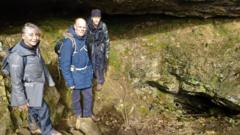What Secrets Do Bronze Age Cattle Remains Unearth in a Cave?

Unveiling Yorkshire's Prehistoric Secrets: The Discovery of Bronze Age Cattle Remains
The recent archaeological findings in the Yorkshire Dales have unveiled a treasure trove of information about prehistoric life. Researchers discovered the remains of an extinct breed of cattle known as the auroch, which roamed Europe before their extinction in the 17th century. This remarkable discovery not only provides insights into the fauna of the Bronze Age but also sheds light on human activities in the region during the Neolithic period. The excavation, part of the Ingleborough Cave Archaeology Project, aims to secure the future of upland commons in the Yorkshire Dales and beyond, while also emphasizing the role of local cavers in revealing the past.
The Significance of Aurochs in Prehistoric Context
Aurochs were massive wild cattle that inhabited a variety of environments across Europe, including the dense forests and open grasslands. They are recognized as the wild ancestors of modern domestic cattle. Their extinction was primarily attributed to habitat loss and extensive hunting practices, which significantly diminished their populations. The discovery of auroch remains in the Yorkshire Dales is crucial for understanding the ecosystem dynamics and human interactions with these majestic creatures during the Bronze Age.
The Archaeological Discovery: A Closer Look
Archaeologists, collaborating with experienced cave explorers, uncovered the remains while surveying various caverns and sinkholes near Ingleborough. This area, known for its rich archaeological potential, has long been a site of interest for researchers aiming to unravel the historical narratives hidden beneath the surface. The team's findings included not only the auroch remains but also evidence suggesting that the caves served as human burial sites during the Neolithic period. This dual significance of the cave sites offers a glimpse into the lives of those who lived and farmed in the Dales long ago.
Understanding Human Interaction with the Environment
The Ingleborough Cave Archaeology Project is part of a broader £3 million initiative funded by the National Lottery Heritage Fund. The project's goal is to explore sustainable land management practices and preserve the cultural heritage of the region. One of the key aspects of the project is to engage contemporary farmers in understanding and implementing adaptive approaches to land management, drawing from the long-standing traditions of commoning that have shaped the landscape over centuries.
The Importance of Commoning Traditions
Ingleborough is one of the few remaining areas in England where commoning traditions persist. This practice allows farmers to graze livestock on shared land, a right that dates back to the Magna Carta. With around a dozen farmers still practicing these traditions, there is a rich cultural tapestry that connects modern agricultural practices with prehistoric land use. Understanding how early communities interacted with the landscape can provide valuable lessons for contemporary farmers seeking to maintain biodiversity and sustainability.
Engaging Local Cavers in Archaeology
Rick Peterson, a caving archaeologist at the University of Central Lancashire, highlighted the vital role local cavers play in archaeological discoveries. Often, it is these experienced individuals who first encounter significant finds due to their specialized skills in navigating hard-to-reach cave systems. The partnership between cavers and archaeologists ensures that these discoveries are properly documented and studied, contributing to a more comprehensive understanding of the region's history.
The Broader Implications of the Findings
The discoveries made in the Yorkshire Dales go beyond mere archaeological interest. They raise important questions about human interaction with the environment, land use over millennia, and the need for sustainable practices in modern agriculture. As urbanization and industrial farming continue to threaten traditional practices, understanding the historical context of land management becomes increasingly crucial.
Lessons for Modern Agriculture
The project emphasizes the importance of preserving ancient agricultural practices to ensure the sustainability of current farming methods. By examining the long history of human interaction with the land, farmers today can learn valuable lessons about biodiversity, resource management, and the impacts of climate change. Engaging with the past can inspire innovative approaches that respect the land while meeting contemporary agricultural needs.
Supporting Local Biodiversity
Maintaining biodiversity is essential for the health of ecosystems. The project highlights the interdependence of various species and the habitats they occupy. By understanding how prehistoric communities managed their landscapes, modern farmers can adopt practices that support local wildlife and promote ecological balance. This holistic approach can enhance soil health, improve crop yields, and create resilient farming systems that can withstand environmental challenges.
Preserving Cultural Heritage
In addition to environmental sustainability, the project underscores the importance of preserving cultural heritage. The caves of Ingleborough not only hold archaeological treasures but also stories of the people who once inhabited the region. By documenting and sharing these narratives, we can foster a greater appreciation for the history of our landscapes and the communities that shaped them. The integration of cultural heritage into modern land management practices can enrich local identities and strengthen community ties.
Looking Ahead: The Future of the Ingleborough Cave Archaeology Project
The Ingleborough Cave Archaeology Project represents a significant step toward understanding the deep-rooted connections between humanity and the landscape. As excavations continue, researchers anticipate uncovering even more insights into the lives of those who lived in the Dales thousands of years ago. The collaboration between archaeologists, cavers, and local farmers will be pivotal in ensuring that these discoveries inform sustainable land management practices for future generations.
FAQs about the Archaeological Discoveries in Yorkshire Dales
What is an auroch, and why is it significant?
An auroch is an extinct species of wild cattle that roamed Europe before becoming extinct in the 17th century due to habitat loss and hunting. They are considered the wild ancestors of modern cattle, making their remains significant for understanding agricultural history and biodiversity.
What were the caves used for during the Neolithic period?
The caves in the Yorkshire Dales served multiple purposes during the Neolithic period, including as burial sites. They provide valuable insights into the social and cultural practices of prehistoric communities.
How do commoning traditions impact modern agriculture?
Commoning traditions allow farmers to graze livestock on shared land, fostering community ties and sustainable land use. Understanding these practices can help modern farmers adopt more environmentally friendly and adaptive management strategies.
What role do cavers play in archaeological discoveries?
Experienced local cavers often discover significant archaeological finds due to their specialized skills in accessing remote cave systems. Their partnership with archaeologists ensures that these discoveries are documented and studied, contributing to our understanding of history.
The discoveries in the Yorkshire Dales remind us of the intricate tapestry of life that once thrived on our land. As we uncover the past, we carry the responsibility to protect and preserve our cultural and natural heritage for future generations. How will we ensure that the lessons learned from our ancestors inform our practices today? #Archaeology #CulturalHeritage #SustainableFarming
Published: 2025-08-05 01:07:15 | Category: technology



